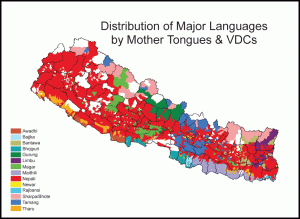Nepali
About Nepali Language
University of Wisconsin-Madison Students in African 671
Nepali is an Indo-Aryan language and the official language of Nepal. It is spoken by about 17 million people worldwide, predominantly in Nepal, Bhutan, and India. Nearly 45% of Nepal’s population speaks Nepali as a first language, while 33% speaks it as a second language. With over 100 languages/mother tongues existing in Nepal’s diverse landscape, there are multiple dialects of Nepali and it is predominantly known as a ‘hill’ language. It is used in all official government documents and correspondence. Comparing to a US context, Nepali is the ‘English’ of Nepal.

Written Nepali uses Devanagari script (derived from Sanskrit) and is used in multiple languages throughout South Asia. Nepali Devanagari most closely resembles Hindi, however, it uses a unique orthography to match Nepali pronunciations of the alphabet. Nepali is a highly phonetic language including diphthongs and nasal vowels, which requires technical tongue placement and aspirations.
There are 12 vowels and 36 consonants in Nepali Devanagari, and the script is written from left to right, with a top horizontal line indicating the separation of words and a vertical line used as punctuation in between sentences. The script very closely resembles the pronunciation, which can be considered helpful for language learning.
For foreign language learners, the structure of subject-object-verb in Nepali is important to note, as well as verb inflections to show the contrast between honorific pronouns. There are three (and sometimes even four) honorifics used for the second and third person, which are very important to use appropriately to demonstrate respect.
Works Cited:
Bal, B. K., & Pustakalaya, M. P. (n.d.). Structure of Nepali Grammar. N/A. https://citeseerx.ist.psu.edu/viewdoc/download?doi=10.1.1.542.8238&rep=rep1&type=pdf
Central Bureau of Statistics. 2013. p. 4. Archived from the original (PDF) on 17 July 2013. Retrieved 14 June 2021.
Jain, Danesh; Cardona, George (26 July 2007). The Indo-Aryan Languages. ISBN 9781135797119.
Parshuram Tamang et al. Nepal Statistics and Indigenous Peoples. Kathmandu: Nepal Tamang Ghedung 2006
The Department of Asian Studies. (2021). Nepali. Cornell University: The College of Arts & Sciences. https://asianstudies.cornell.edu/nepali
Page Contributors:
Samantha Helle – Nelson Institute for Environmental Studies, University of Wisconsin-Madison
Grace Wright – Global Studies, University of Oregon

